Luigi Bazzani
Luigi Bazzani, also called Il Bazzanetto, was an Italian painter , illustrator, and watercolorist. He was born November 8, 1836 in Bologna, Italy. Bazzani studied at Bologna's Accademia di Belle Arti then traveled to France, Germany and, eventually, Rome where he settled down in 1861 and began to specialize in genre and landscape subjects as well as set designs for theaters.[1] Many of his paintings featured the remains of the city's monuments from classical antiquity.[2]
Luigi Bazzani | |
|---|---|
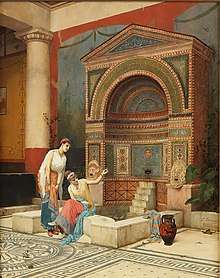 Women feeding fish in a Pompeian Atrium by Luigi Bazzani | |
| Born | Luigi Bazzani 8 November 1836 Bologna, Italy |
| Died | 2 February 1927 (aged 91) |
| Nationality | Italian |
| Known for | Painting |
| Movement | Academicism, Neoclassicism |
Documentation of Pompeii excavations
Inspired by the rediscovery of Pompeii in 1748, he spent 35 years of his life from approximately 1880 to 1915 documenting the ruins of the ancient city that had been exposed by ongoing excavations with watercolor paintings. Bazzani experimented with the techniques of architectural relief, an aspect so far little known but of great interest for archaeological research[2] and his attention to detail was prized by scientists working at the site. His often exquisitely muted colors and his superb technical skill enabled him to replicate antique stone, whether chipped facing or other decaying aspects of it.[3] At the time of Bazzani's work in Pompeii, the freshly excavated remains were still vibrant with original paint.
He contributed a series of fourteen illustrations to a publication by Pompeii's leading archaeologist Amedeo Maiuri.[4] Since then, however, many interiors have been lost to deterioration. So his work has been a valuable resource for modern archaeologists and scholars as well.[5]
Exhibitions
Beginning in 1895, Bazzani exhibited regularly in Rome, Vienna, Munich, Berlin, and Paris. He also taught perspective and set design at the Academia di Belle Arti in Rome from 1892 to 1896 with Ludovico Zeit[1] and had prize-winning artist Luigi Savoldi as a pupil.[6] Eventually, Bazzani became a member of academies in Rome, Bologna, and Perugia.[1] In 2013, the exhibition "Really! The Pompeii of the late 1800s in the painting of Luigi Bazzani" was presented by The Fondazione del Monte di Bologna, in collaboration with the University of Bologna (Department of History, Civilization Cultures, Section of Archeology). It included a multimedia application developed by the Italian consortium of universities and research centers known as Cineca that integrated images of Bazzani's watercolors into their appropriate locations in Pompeii's archaeological structures as viewed through Google Earth.[5]
Gallery
Pompeii watercolors (See more by clicking on the Wikimedia Commons link)
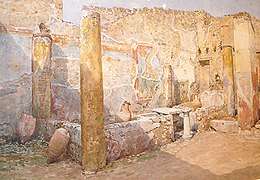 Summer Triclinium of House V, 2, 15, 1914
Summer Triclinium of House V, 2, 15, 1914 Pompeii Bath
Pompeii Bath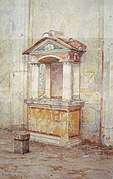 Lararium of the House of Dioscuri, 1902
Lararium of the House of Dioscuri, 1902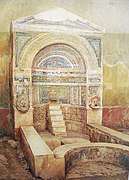 House of the Great Fountain
House of the Great Fountain Atrium of the House of the Centenary, 1901
Atrium of the House of the Centenary, 1901.jpg) Peristyle with fountain in the House of Marcus Lucretius
Peristyle with fountain in the House of Marcus Lucretius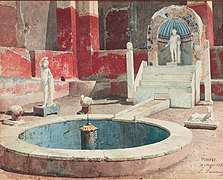 Peristyle with fountain in the House of Marcus Lucretius (Detail)
Peristyle with fountain in the House of Marcus Lucretius (Detail).jpg) Pompeii Interior
Pompeii Interior.jpg) Pompeii theater
Pompeii theater.jpg) Lararium of the House IX,1,7, Pompeii,1903
Lararium of the House IX,1,7, Pompeii,1903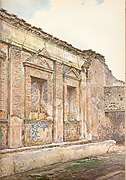 Nymphaeum at the House of the Bull, 1901
Nymphaeum at the House of the Bull, 1901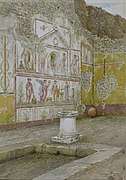 Atrium of the House of the Mariner
Atrium of the House of the Mariner_before_1927.jpg) House of the Vetti
House of the Vetti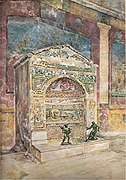 House of the Small Fountain
House of the Small Fountain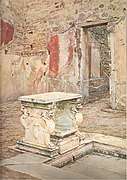 House with impluvium and marble table
House with impluvium and marble table Insula in Region IX, V, 18
Insula in Region IX, V, 18 Temple of Isis
Temple of Isis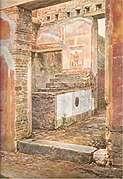 Thermopolion (fast food stall) in the alley of the rooster
Thermopolion (fast food stall) in the alley of the rooster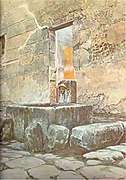 Fountain with head of Mercury on Mercury Street
Fountain with head of Mercury on Mercury Street House of the Hanging Balcony
House of the Hanging Balcony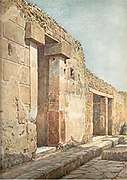 Portal of a patrician house on Augustus Street
Portal of a patrician house on Augustus Street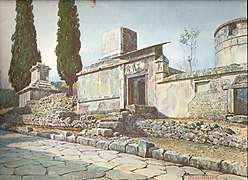 Tomb in the necropolis
Tomb in the necropolis Tomb with covered niche and planter with garland
Tomb with covered niche and planter with garland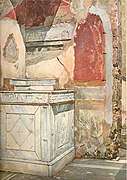 Lararium in the House of L Caecilius Jucundus
Lararium in the House of L Caecilius Jucundus Pompeii Atrium
Pompeii Atrium Arches of Nero in the Forum
Arches of Nero in the Forum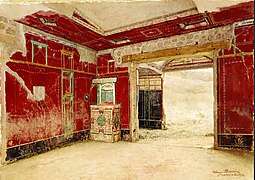 Pompeian red interior
Pompeian red interior_of_the_House_of_Sallust_(VI_2%2C_4)_in_Pompei_watercolor_by_Luigi_Bazzani.jpg) The Genaeceum (Women's Quarters) of the House of Sallust (VI 2, 4)
The Genaeceum (Women's Quarters) of the House of Sallust (VI 2, 4)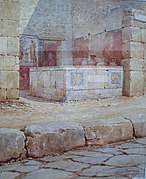 Thermopolium in the Alley of the Pharmacist
Thermopolium in the Alley of the Pharmacist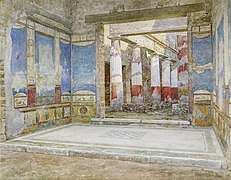 Atrium of the House of the Ancient Hunt
Atrium of the House of the Ancient Hunt_in_Pompeii_watercolor_by_Luigi_Bazzani.jpg) Atrium of the House of the Ancient Hunt (Detail)
Atrium of the House of the Ancient Hunt (Detail)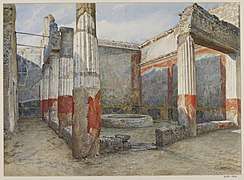 Atrium of the House of the Ancient Hunt in Pompeii
Atrium of the House of the Ancient Hunt in Pompeii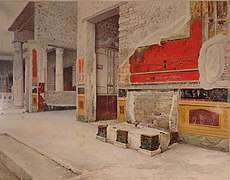 Atrium of the House of the Vetti VI.15.1
Atrium of the House of the Vetti VI.15.1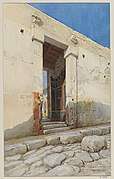 Entry to a Roman domus
Entry to a Roman domus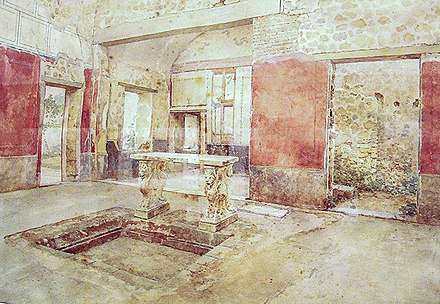 Atrium of the House of the Prince of Naples
Atrium of the House of the Prince of Naples_in_Pompeii_watercolor_by_Luigi_Bazzani.jpg) Fountain of the House of C. Virnius Modestus (IX 7, 16)
Fountain of the House of C. Virnius Modestus (IX 7, 16)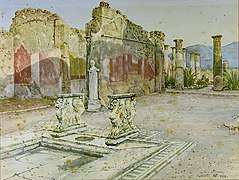 Atrium of the House of Cornelius Rufus
Atrium of the House of Cornelius Rufus Colonnade of the House of Cornelius Rufus
Colonnade of the House of Cornelius Rufus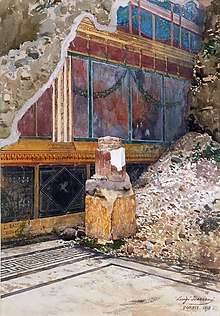 House of the Silver Wedding
House of the Silver Wedding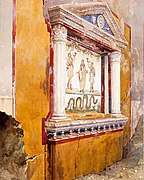 Lararium of a family altar, seen in situ after excavation, House of Aulus Vettius, Pompeii, c36-39 CE, 1895
Lararium of a family altar, seen in situ after excavation, House of Aulus Vettius, Pompeii, c36-39 CE, 1895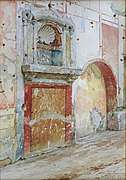 Lararium of the House of Paccius Alexander (IX 1, 7)
Lararium of the House of Paccius Alexander (IX 1, 7)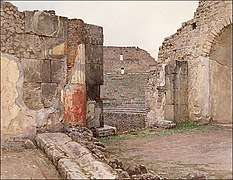 Large theater in Pompeii, 1910,
Large theater in Pompeii, 1910, Pompeii forum
Pompeii forum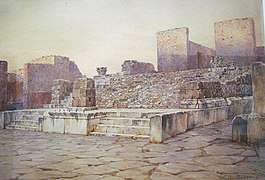 The Temple of Fortuna Augusta
The Temple of Fortuna Augusta
Rome's monuments
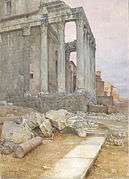 Temple of Antonino and Faustina, Rome
Temple of Antonino and Faustina, Rome Anaglyph of Trajan in the Roman Forum, 1897
Anaglyph of Trajan in the Roman Forum, 1897 Temple of Saturn by Luigi Bazzani, 1894
Temple of Saturn by Luigi Bazzani, 1894_by_Luigi_Bazzani.jpg) Arch of Septimius Severus in Rome (Detail)
Arch of Septimius Severus in Rome (Detail)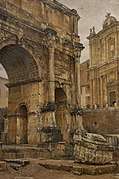 Arch of Septimius Severus in the Forum Romanum
Arch of Septimius Severus in the Forum Romanum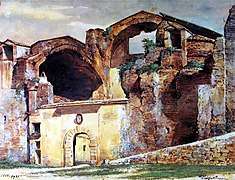 Termini ruins in Rome
Termini ruins in Rome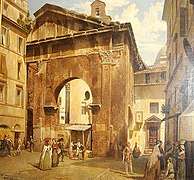 Portico of Octavia
Portico of Octavia The Young Flower Seller
The Young Flower Seller
Neoclassical genre paintings
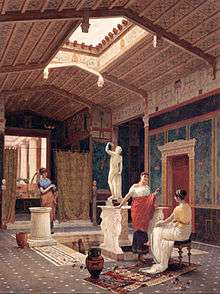 Atrium in Pompeii
Atrium in Pompeii Women feeding fish in a Pompeiian atrium
Women feeding fish in a Pompeiian atrium_by_Luigi_Bazzani%2C_before_1927.jpg) Women in a Pompeian Atrium feeding fish (Detail)
Women in a Pompeian Atrium feeding fish (Detail)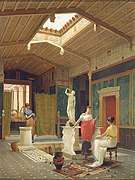 A Pompeian Interior
A Pompeian Interior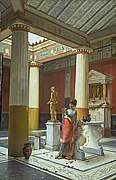 A Roman Interior
A Roman Interior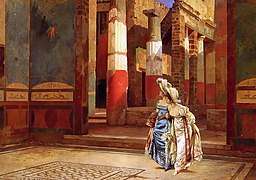 A visit to Pompeii
A visit to Pompeii Beauties in an Interior, 1879
Beauties in an Interior, 1879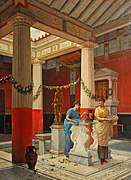 Decorating the Temple, 1887
Decorating the Temple, 1887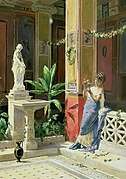 In a Courtyard in Pompeii,1878
In a Courtyard in Pompeii,1878 Pompeii atrium
Pompeii atrium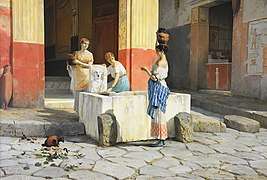 Women at the well
Women at the well.jpg) Roman life
Roman life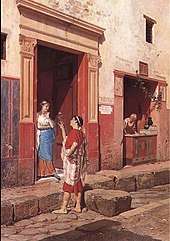 Pompeii Street Scene
Pompeii Street Scene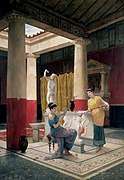 Women in a Pompeian Atrium
Women in a Pompeian Atrium Picking flowers from the courtyard
Picking flowers from the courtyard Fruit seller in the courtyard of a Pompeian Villa, 1876
Fruit seller in the courtyard of a Pompeian Villa, 1876
Death
| Wikimedia Commons has media related to Luigi Bazzani. |
Luigi Bazzani died on February 2, 1927 in Rome, Italy.[1]
References
- Luigi Bazzani, A Pompeian Interior, 1882 Dahesh Museum of Art, retrieved 8/22/2019.
- The Pompeii of the late nineteenth century in the painting of Luigi Bazzani retrieved 8/22/2019.
- Luigi Bazzani, Old Master Drawings and Sketches, retrieved 9/1/2019.
- Luigi Bazzani, Pompeiian Interior, 1875 St. Johnsbury Athenaeum retrieved 8/22/2019.
- Browsing Historical Pompeian watercolours through a Google Earth-based meta interface: Luigi Bazzani's Exhibition by A. Coralini, A. Guidazzoli, Mc.C. Ligouri, A. Baglivo and M. Spigarolo Retrieved 8/22/2019.
- Pietro Moscow: Art and costume in Bergamo Nineteenth-twentieth century, p. 954, Graphic and Art Editions, Bergamo , 1990